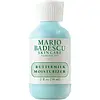What's inside
What's inside
 Key Ingredients
Key Ingredients

 Benefits
Benefits

 Concerns
Concerns

 Ingredients Side-by-side
Ingredients Side-by-side

Water
Skin ConditioningIsopropyl Myristate
EmollientPropylene Glycol
HumectantParaffinum Liquidum
EmollientGlyceryl Stearate
EmollientCetyl Alcohol
EmollientAllantoin
Skin ConditioningChamomilla Recutita Flower Extract
MaskingThymus Vulgaris Leaf Extract
Skin ProtectingTocopherol
AntioxidantLactic Acid
BufferingCetrimonium Bromide
AntimicrobialParfum
MaskingTriethanolamine
BufferingMethylparaben
PreservativePropylparaben
PreservativeSodium Chloride
MaskingCitronellol
PerfumingCI 42090
Cosmetic ColorantCI 19140
Cosmetic ColorantWater, Isopropyl Myristate, Propylene Glycol, Paraffinum Liquidum, Glyceryl Stearate, Cetyl Alcohol, Allantoin, Chamomilla Recutita Flower Extract, Thymus Vulgaris Leaf Extract, Tocopherol, Lactic Acid, Cetrimonium Bromide, Parfum, Triethanolamine, Methylparaben, Propylparaben, Sodium Chloride, Citronellol, CI 42090, CI 19140
Water
Skin ConditioningCaprylic/Capric Triglyceride
MaskingGlycerin
HumectantPolyglyceryl-3 Methylglucose Distearate
EmulsifyingPropanediol
SolventStearyl Alcohol
EmollientSodium Acrylate/Sodium Acryloyldimethyl Taurate Copolymer
Emulsion StabilisingStearic Acid
CleansingPanthenol
Skin ConditioningSodium Benzoate
MaskingDicaprylyl Ether
EmollientSorbitol
HumectantC15-19 Alkane
SolventPolyglyceryl-6 Laurate
EmulsifyingAllantoin
Skin ConditioningBisabolol
MaskingCitric Acid
BufferingPolyglycerin-6
HumectantTocopheryl Acetate
AntioxidantWater, Caprylic/Capric Triglyceride, Glycerin, Polyglyceryl-3 Methylglucose Distearate, Propanediol, Stearyl Alcohol, Sodium Acrylate/Sodium Acryloyldimethyl Taurate Copolymer, Stearic Acid, Panthenol, Sodium Benzoate, Dicaprylyl Ether, Sorbitol, C15-19 Alkane, Polyglyceryl-6 Laurate, Allantoin, Bisabolol, Citric Acid, Polyglycerin-6, Tocopheryl Acetate
Ingredients Explained
These ingredients are found in both products.
Ingredients higher up in an ingredient list are typically present in a larger amount.
Allantoin is a soothing ingredient known for its protective and moisturizingg properties. Because of this, it is often added to products with strong active ingredients.
Studies show higher concentrations of this ingredient can promote wound healing.
Though it can be derived from the comfrey plant, allantoin is produced synthetically for cosmetic products to ensure purity.
Learn more about AllantoinWater. It's the most common cosmetic ingredient of all. You'll usually see it at the top of ingredient lists, meaning that it makes up the largest part of the product.
So why is it so popular? Water most often acts as a solvent - this means that it helps dissolve other ingredients into the formulation.
You'll also recognize water as that liquid we all need to stay alive. If you see this, drink a glass of water. Stay hydrated!
Learn more about Water